August 2010
Monthly Archive
Tue 31 Aug 2010
Posted by Karl under
GuitarsNo Comments
Playing acoustic guitar in a band setting comes with a unique set of challenges. Whether you’re playing acoustic or electric guitar in a band, every guitarist has the same basic needs:
1. The need for great tone. “Tone” of course is subjective, but it’s not much fun playing if you think your tone sucks.
2. The need to be able to hear what you’re playing. If you’re being drowned out by the drummer or other musicians, you can keep playing and hope for the best but it’s a major drag when you can’t hear yourself.
3. The need to be in control of your sound. With an acoustic guitar or semi-hollow electric guitar, as volume levels rise, so does the likelihood of feedback. Controlled feedback is good, uncontrollable feedback equals vibe killer. The need for higher volume levels before feedback is one of the reasons the solid body electric guitar was invented.
I play a fair bit of acoustic guitar with The Malarkeys, and I’ve had to adapt to play with drums, bass, accordion, fiddle, and sometimes keyboard. It’s a demanding situation for an acoustic guitar.
Acoustic Guitar Pickup
Until this year, I was playing an Ibanez AW-10CE NT, which has a built-in pickup system that includes an onboard EQ. It has a phase reversal switch to help prevent feedback. It also features a very unusual XLR output jack in addition to a standard ¼” jack. The whole system works very well and the sound is nicely balanced. It works well either through a guitar amp or direct into a PA system.
This year I got another acoustic guitar which is now my main acoustic instrument, a Gibson J45. It features a built-in pickup from L.R. Baggs. There are no tone controls or anything, just a volume wheel discreetly located inside the sound hole. The sound is full and works very well in a band context. The J45 also sounds beautiful on its own.
Amplification
When amplifying an acoustic guitar, there are four main choices.
1. Point a microphone at the guitar and run the signal into a PA system. This is usually the best way to reproduce the truer acoustic sound of the guitar. The drawback is that the player can’t move around; if you step away from the mic your sound drops out and no one will hear you. The technique is also next to impossible if there are other loud musicians playing with you; the microphone will be very susceptible to feedback if the stage volume gets aggressive.
2. Use a built-in or clip-in pickup and send the signal to a PA system. This is a very popular method, particularly if you have a pro sound system and a sound technician running it. If the sound engineer knows what they’re doing, they should be able to provide enough on-stage monitoring so everyone can hear the acoustic guitar, and they can make sure enough signal goes to the front of house so the guitar is in the mix properly. For small gig situations with no sound engineer, this is still a popular choice. One potential drawback is that acoustic guitars can sometimes sound very tinny and thin when amplified this way, so you’ll see some guitarists run their signal into an acoustic guitar preamp or direct box first, and then to the PA. A preamp helps adjust the level the guitar is sending to the PA and usually includes tone-shaping circuitry and/or EQ.
3. Plug the guitar’s pickup into an acoustic guitar amplifier. This can provide a good sound and provide lots of control over your sound. Many amps will have a line out for sending a signal to the PA, and having an amp on stage can act as your personal monitor so you can hear what you’re playing. One downside of this approach is that if you’re switching back and forth between acoustic and electric guitars on the same gig, then you need to bring two amps, really; one for the acoustic and one for the electric, because the electric guitar amp will be voiced differently, and usually include features like overdrive.
4. Plug the guitar into a regular guitar amp, and put a mic on the amp’s speaker to send a signal to the PA. The reason for the mic on the amp speaker is that with many guitar amps, a line out an effects send jack, sends the signal out before it has been processed by the amp’s EQ section. Consequently, you may be hearing a wonderful tone through the amp, but the PA is getting an undoctored sound that can be thin and wimpy. I go with this option most of the time, for a number of reasons. I’ve got a video demonstrating how it sounds on YouTube.
There are many variations on these techniques, and you’ll want to experiment within the parameters of your band, your playing situations, your PA system, and of course your budget.
Preventing Feedback
Some acoustic guitarists will stuff their acoustic guitars full of foam to help prevent feedback. Personally, I’ve never done that, but I would recommend picking up a sound hole cover. They’re inexpensive, and they help a lot. Your guitar will still sound OK acoustically, but you’ll be able to get more amplified volume before feedback occurs.
Mon 30 Aug 2010
Posted by Karl under
GuitarsNo Comments
I own a Fender F-55-12 12-string acoustic guitar. Mine is sort of like the Toyota Corolla of 12-strings, nothing fancy but it gets me where I want to go every time. It’s a ply top, and features a built-in pickup. The pickup has no controls whatsoever. I know that doesn’t sound too promising, but actually this instrument works remarkably well. I’ve used it on tons of gigs and on several recordings (you can hear it on the song Time Machine). It has cheapo looking tuners, but it stays in tune quite well. It sounds great amplified, with no fuss at all.
This is the second 12-string guitar I’ve owned. When I was much younger, I bought a Framus 12-string, in 1974. According to Wikipedia, Framus went bankrupt the next year. I have always been a big Beatles fan, and the 12-string sound was something I wanted to get into for learning songs like Here Comes the Sun. I tuned the Framus at regular pitch, and after several years, the incredible tension that twelve strings exert on the top of the guitar starting warping the top. I didn’t know what to do about it at the time, so I did nothing and just kept on playing it. Eventually the warping behind the bridge just got to be too much and it was clear that the guitar had become unplayable. As the top warped and the bridge shifted, tuning the guitar became hopeless. I can’t remember what I did with that guitar. I somehow can’t imaging I threw it out. I probably gave it away to someone who wanted to hang it on a wall or turn it into a clock, I don’t know.
By the time the Fender 12-string came into my life, as a used guitar with its share of dings and scratches, I knew a bit more about the care and maintenance of guitars. That’s not to say I always do what I should to look after it, but at least I knew more about it. Like many 12-string players, I tune the Fender 12-string down a whole step, and capo it at the second fret. I play a lot of Celtic-influenced music with it these days, and in lots of different keys. I like playing open chords as much as possible, especially with the 12-string, so if we’re playing something in an inconvenient key, I move the capo to whatever fret I need, and then move it back to the second fret when we’re done. The problem with that is that getting the tuning just right on the 12-string takes a little time.
When I’m tuning it, I put the capo on the second fret and then tune it like a regular guitar.
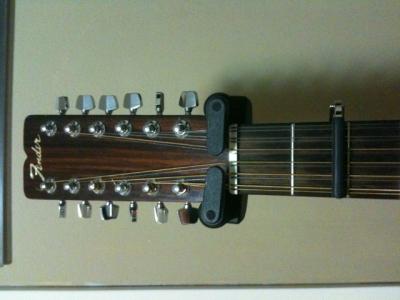
I usually tune the treble E strings first, then the low E’s, then the B’s, the A’s, the G’s and finally the D’s. If I then move the capo to another fret, when I return it to the second fret I have to put it back exactly where it was or my tuning will be out of whack. I recently found a solution to this little dilemma; it may be perfectly obvious to you, but I’d never seen it done. It occurred to me to treat the second-fret capo like a nut, never to be moved once I got the strings in tune. The answer is to use a second capo for those other fret positions, and leave the first capo alone. It might look a little funny, but it works.
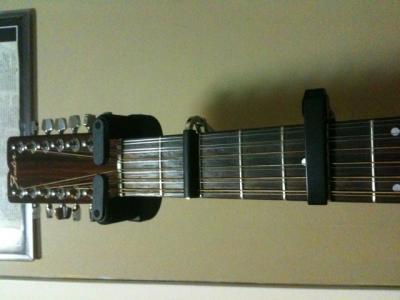
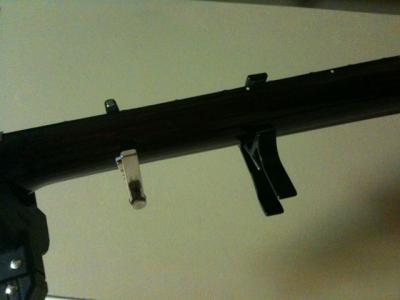
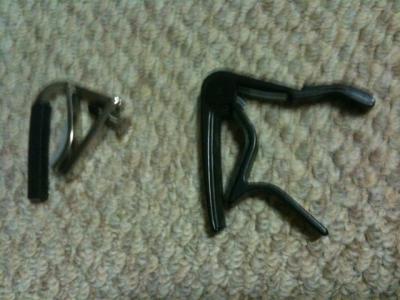
Sun 29 Aug 2010
Posted by Karl under
GuitarsNo Comments
The Robert Cray model Strat is one of my very favourite Fender Stratocaster models. I own one, and it’s killer. I made one modification to mine, and that was the bridge saddles. The replacement saddles are a big improvement in comfort and sustain. Interestingly enough, after I had made the change, I saw a few pictures of Robert Cray’s own guitars, and he’s had the same modification done to the bridge, replacing the stamped metal bridge saddles. So, maybe something like these should be stock issue. How about it, Fender?

If I could make one other change, it would be to the truss rod access. Placing it at the heel end, old-school style, is really inconvenient. Twenty-two frets would be a bonus, too, since I’m thinking about the neck.
If you haven’t played a Robert Cray model Stratocaster, check it out. The hardtail (non-vibrato) bridge means you can bend strings without pulling other ringing notes out of tune. The neck looks and feels great, with a lovely warm coloured finish. The middle pickup is reverse wound, so single coil hum is greatly reduced in the second and fourth pickup selection positions. Depending on the amp you use, this guitar can play nicely with others or breathe fire.
Sat 28 Aug 2010
Posted by Karl under
GuitarsNo Comments
When Gibson launched the Les Paul model solid body electric guitar in the 1950’s, they hit on an extraordinarily successful design that is still in demand today. Before the 50’s were done, Les Paul models included several features that are still the benchmark as must-have features on any quality electric guitar:
• a cutaway on the guitar shoulder allows easier access to the higher frets, an absolute necessity for any modern player today
• a two pickup configuration, the basic foundation of many tonally versatile electric guitars
• an adjustable bridge, for accurate intonation no matter what gauge of string is being used
Gibson has introduced many different solid body electric guitars over the years, either based on the Les Paul or as a complete departure from that design template (or as auto manufacturers would say, “platform”). The selection of Les Paul styles available now is amazing, with something for almost every budget. The most popular models stick close to the traditional platform, although Gibson have been very creative and untraditional with models like the Les Paul Standard 2010 Limited model, which features just about every imaginable sonic variation you could ask for with its dizzying array of pickup possibilities, not to mention Gibson’s somewhat unfortunately named Robot Tuning technology.
At an MSRP of over $6000USD, it’s not for everyone. But if there was going to be a new fangled Les Paul for everyone, I offer three simple suggestions for a design update that can retain the same sound, and very nearly the same look, as the tradition demands.
1. Reconfigure the volume and tone controls. They’re too far away. Let’s go from this:

to this:

2. Move the pickup selector switch and put it behind the stop tailpiece. It’s more efficient and you’re less likely to hit it by accident.
3. Add coil taps to the pickups, so they can be used in humbucking or single coil mode. This is already available on a very limited number of models, but as a standard feature it would add a lot of sonic variety to an iconic guitar.
There it is, three little ideas to update the Les Paul without stepping too far away from its venerable roots. If Gibson incorporated those three ideas into a new Les Paul platform, they could then offer all kinds of variations on the theme. Maybe they could call it the 21-Series, as in 21st century. I’d have to have one, that’s for sure!
Fri 27 Aug 2010
Posted by Karl under
GuitarsNo Comments
I’ve been having fun fantasizing about my very own signature model Les Paul. I’ve been fussy and opinionated on a few points, and quite passive and accepting about other aspects of the design. When it comes to the electronics, though, I have a specific notion about what I’d like. First of all, let me say that I’m good with either a pair of big chrome covered PAFs, or a more hot rod looking pair with no covers, like the Les Paul Studio Deluxe ‘60s model. Either way, they’ll sound like a Les Paul to me. They need a collar around the pickups, and those collars can be plastic, any colour that complements the finish.
Controlling those pickups is another matter. It has always seemed to me that the volume and tone controls for the Les Paul are sort of in the wrong place; same thing with the pickup selector switch. I’m always bumping it when I don’t mean to.

I want the pickup selector switch placed behind the stop tailpiece. I’ve seen that on a few early B.C. Rich guitars, and I had a custom built guitar that had that configuration and it works great. That custom guitar, by the way, was a Les Paul style guitar made from walnut. It was a beauty, and unfortunately was stolen from my home. Maybe some day I’ll run across it on ebay.
One very cool feature about the Fender Stratocaster’s volume control is that the pot is situated close to the bridge and within easy distance of your little finger. It’s ideal for subtle volume swells, and not so subtle volume swells, come to that. I think my ideal Les Paul would borrow from that idea and place the bridge pickup volume near the bridge pickup and the bridge. The other front pot would be the neck pickup volume, and the remaining two controls would be their respective tone controls. One more wrinkle – I want the bridge pickup volume pot to be logarithmic instead of linear, same as a Strat.
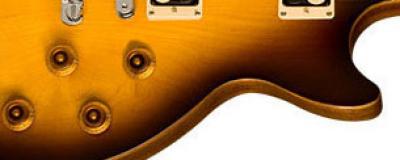
If you aren’t cursing at your computer screen yet, let me ask for one more thing. I’d like a little discrete mini switch smack in the middle of those volume and tone pots. The switch would throw the two humbuckers out of phase with each other, so you’d only notice the effect when the pickup selector switch is in the middle (both pickups) position. Speaking of the pickup selector switch again, I don’t want the little plastic collar that says Rhythm and Treble. Please leave it off, I get which position is which without that little advisory.
I noticed that the Les Paul Studio Deluxe ‘60s described on Gibson’s site features bridge and neck pickups that can each be split via their own push/pull switch on the volume knob to achieve a single-coil tone. Sweet idea, I could go for that for sure!
OK, I’ve talked about the body, the colours choices, the finishing details, the neck, the fingerboard, tuning pegs, frets, pickups, controls, bridge and tailpiece. Stock strap buttons are fine. That’s about it for the guitar, but I’ll need a standard hardshell case, too.
How do you like my ideas for a signature model Les Paul. What to call it?
How about the Les Paul Heretic model? Or do you think my ideas are not that radical? Would you like to see a Les Paul like the one I’ve described over the last few days?
Thu 26 Aug 2010
Posted by Karl under
GuitarsNo Comments
Guitar necks can be slim or fat or anything in between, and it’s a matter of personal taste as to what’s best for you. With just about any Les Paul I’ve ever picked up and played, the neck is fine as it is. In other words, I haven’t really felt a Les Paul neck I didn’t like the feel of, so I don’t really have a preference for my fantasy signature model Les Paul’s neck. Just give me a stock neck and I’m good, as far as the feel is concerned.
When I was describing the body of the Les Paul I’d like, I expressed a preference for binding on the body. Aesthetically, it might be a good idea to carry that look down the neck with neck binding. Binding on the neck costs more money, I presume, and on that basis I could forego the neck binding. What I do insist on though, are large clear fret markers on the side of the neck, whether it’s sporting binding or not.
For the fretboard, ebony is lovely, but expensive, so rosewood or just about any substitute works fine for me. I like the look of small dot fret markers, but I actually find they can be very hard to see under some stage lighting conditions, and yes, sometimes I do need to see the frets. That means I want the big block inlays, please.
The nut doesn’t have to be anything special for me. Plastic is fine ,bone is nice, but really plastic works for me. For the tuning pegs, I like silver “kidney” Grovers. They’re reliable, they look good, and they’ll last a long time.
Fret wire can be whatever. I’ve played fretless wonders, I’ve played jumbo fretted Les Paul’s, it’s all good. I don’t really have a preference,
So far I’ve described the body and the neck for my imaginary signature model Les Paul. Actually, the specs described on this (exclusive to Guitar Center shops) Les Paul Studio Deluxe ’60s sound great. Actually, they sounded so good I went and checked out Guitar Center’s web site, but what I found, although it matches the specs, looks ugly compared to the beauty pictured on Gibson’s site. 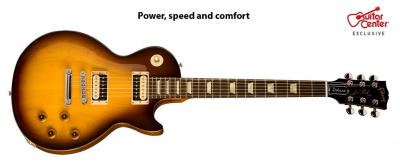 What’s up with that?
What’s up with that?
Tomorrow I’ll fiddle around with the electronics and upset a few purists.
Thu 26 Aug 2010
Posted by Karl under
GuitarsNo Comments
If I had my own signature model Les Paul, designed just for me, I would start with the new chambered Les Paul bodies. Traditionally, Les Paul’s were pretty heavy, and when I was young that might not have been an issue. My 1980 Strat weighs a ton, which is why I hardly play it standing up anymore. It kills my back if I play it for too long. My Robert Cray Strat is a much more manageable weight, so it’s my go-to gigging electric guitar.
Several new Les Paul models feature chambered bodies, which reduce the weight substantially. That’s a big plus for me, so put a check mark beside that feature. Personally, I like the top of the Les Paul to include binding. The models without binding still look good, of course,  but since we’re talking about my fantasy signature model, put a check mark beside binding on the body, please. Skip the pickguard; it hides the beautiful finish, and I don’t need it anyway.
but since we’re talking about my fantasy signature model, put a check mark beside binding on the body, please. Skip the pickguard; it hides the beautiful finish, and I don’t need it anyway.

Speaking of finishes, I have to start with a fairly old school approach, and offer up three solid colours, in high gloss: black, white, and burgundy. Those are my idea of classic Les Paul colours. I also like the look of wood, so a dark grain high gloss mahogany wood finish would also look great. For a maple top, a honey colour that lets the wood grain show would be nice, or maybe Gibson’s Desert Burst sunburst finish. I’d probably pass on most of the other sunburst finishes, especially any with red. I know it’s a classic look, but I’ve never been a big fan of the reddish sunbursts. Maybe it’s because I’ve seen too many crappy copies that looked horrid in a badly done red and yellow sunburst finish. Somehow the Les Paul body seems a little too small for some of the sunburst finishes I’ve seen on them. Save those for the larger ES-335 type of guitars.
As I design my dream signature model Les Paul, I can’t help keeping in mind that I’d also like to be able to actually have a hope of affording it, too, so here I will offer a sacrilegious idea. That high gloss finish I’m craving? I don’t care if it’s polyurethane instead of a nitrocellulose finish. I think that makes a big difference to the tone on acoustic instruments, but on a solid body electric guitar, I need some convincing that it really matters as far as the tone is concerned. It just ages differently, and I don’t mind that my thirty year old Strat still barely has a single chip in it anywhere. That poly finish takes a beating, and if it saves me some money, that would be OK by me. Now, if someone can offer me a really great reason why I’d spend more on a nitro finish for an electric guitar, I’m willing to be convinced, and of course if the Gibson crew just say no to poly, well, nitro it is then.
My signature model would include a stock bridge and tailpiece combo, in silver, not gold.
So far, I’ve got a lightweight chambered body, binding, chrome hardware, no pickguard and a choice of high gloss finishes. Tomorrow, let’s move on down the neck.
Wed 25 Aug 2010
Posted by Karl under
GuitarsNo Comments
Gibson and Fender guitar companies are in the enviable position of having defined the standard in solid body electric guitar designs way back in the 50’s. I can’t think of any guitars that have been more sought after, more copied and more popular than the Gibson Les Paul and the Fender Stratocaster. Both companies got those respective designs so right way back when, that ever since that time it’s been mostly variations on a theme. Today, there are a lot of different Les Paul and Strat models to choose from, but they all still display their heritage with obvious pride.
Personally, I’m fortunate enough to own two Strats. The first one was a gift given to me in 1980. It’s an all black hardtail, with a maple neck. It’s not entirely original anymore. I wore out the bridge saddles to where they had multiple deep grooves where the strings had eaten the metal away. I replaced the originals with a set of black graphite saddles, and I have to say they’re terrific. The package promised more sustain, and they delivered that for sure. They also look cool and feel very comfortable under the heel of my right palm. The original tuning pegs are long gone. They were awful to begin with, and I replaced them early on with a set of, at the time, unheard of tuners from Japan called Gotoh’s. They’re still good as new, and the guitar stays in tune through thick and thin.
My other Strat is a Mexican-made Robert Cray signature model. It’s finished in Inca Silver. I really liked the look of the stamped saddles, but they were uncomfortable and I soon replaced them with a set of off-white graphite saddles which are awesome. Other than that, the guitar is all stock. It’s marvellous to play.

I own a Gibson guitar, but it’s an acoustic, a J-45. I love it.  I also have a Gibson A-4 mandolin. One day I’d like to add a Gibson electric to my collection. My preference would be a Les Paul, I think. But no matter how many Les Paul models I check out, they don’t make one quite the way I’d like it. I could solve that in a flash if I was a famous guitarist and Gibson offered to make me a signature model. If I had my own signature Les Paul, it would build on the tradition, but add a few new twists.
I also have a Gibson A-4 mandolin. One day I’d like to add a Gibson electric to my collection. My preference would be a Les Paul, I think. But no matter how many Les Paul models I check out, they don’t make one quite the way I’d like it. I could solve that in a flash if I was a famous guitarist and Gibson offered to make me a signature model. If I had my own signature Les Paul, it would build on the tradition, but add a few new twists.
Tomorrow I’ll start with the body, and we’ll go from there.








